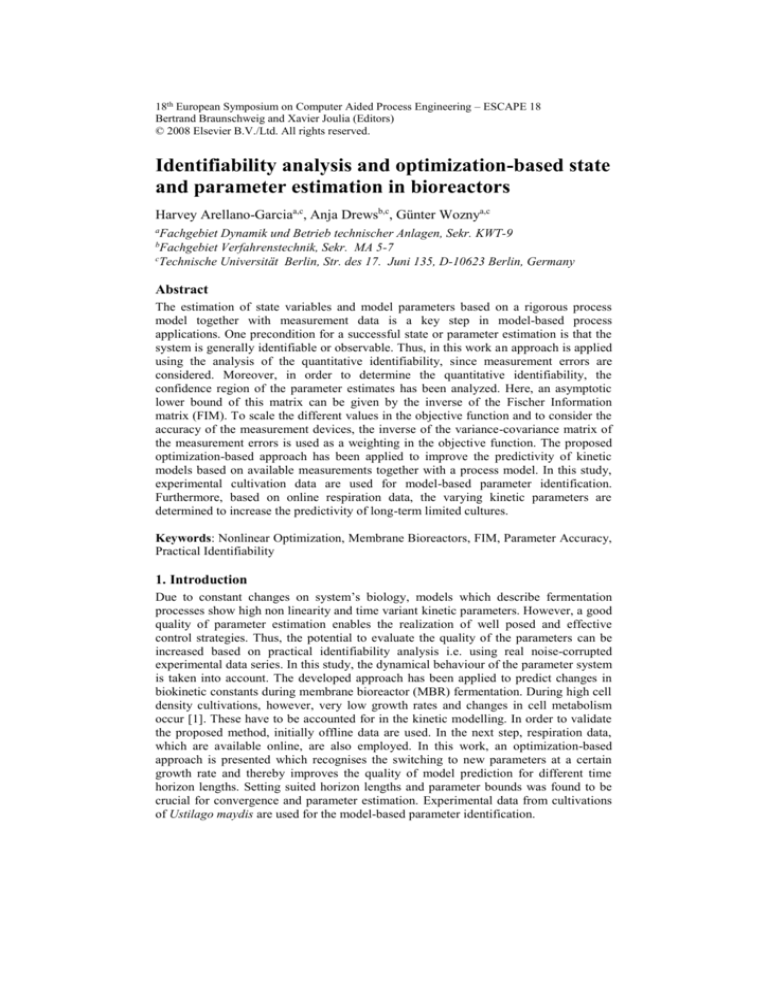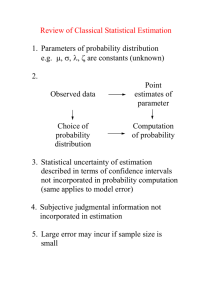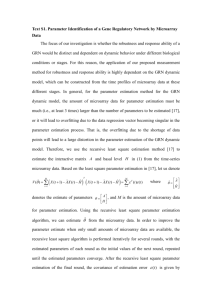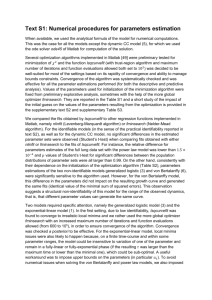
18th European Symposium on Computer Aided Process Engineering – ESCAPE 18
Bertrand Braunschweig and Xavier Joulia (Editors)
© 2008 Elsevier B.V./Ltd. All rights reserved.
Identifiability analysis and optimization-based state
and parameter estimation in bioreactors
Harvey Arellano-Garciaa,c, Anja Drewsb,c, Günter Woznya,c
a
Fachgebiet Dynamik und Betrieb technischer Anlagen, Sekr. KWT-9
Fachgebiet Verfahrenstechnik, Sekr. MA 5-7
c
Technische Universität Berlin, Str. des 17. Juni 135, D-10623 Berlin, Germany
b
Abstract
The estimation of state variables and model parameters based on a rigorous process
model together with measurement data is a key step in model-based process
applications. One precondition for a successful state or parameter estimation is that the
system is generally identifiable or observable. Thus, in this work an approach is applied
using the analysis of the quantitative identifiability, since measurement errors are
considered. Moreover, in order to determine the quantitative identifiability, the
confidence region of the parameter estimates has been analyzed. Here, an asymptotic
lower bound of this matrix can be given by the inverse of the Fischer Information
matrix (FIM). To scale the different values in the objective function and to consider the
accuracy of the measurement devices, the inverse of the variance-covariance matrix of
the measurement errors is used as a weighting in the objective function. The proposed
optimization-based approach has been applied to improve the predictivity of kinetic
models based on available measurements together with a process model. In this study,
experimental cultivation data are used for model-based parameter identification.
Furthermore, based on online respiration data, the varying kinetic parameters are
determined to increase the predictivity of long-term limited cultures.
Keywords: Nonlinear Optimization, Membrane Bioreactors, FIM, Parameter Accuracy,
Practical Identifiability
1. Introduction
Due to constant changes on system’s biology, models which describe fermentation
processes show high non linearity and time variant kinetic parameters. However, a good
quality of parameter estimation enables the realization of well posed and effective
control strategies. Thus, the potential to evaluate the quality of the parameters can be
increased based on practical identifiability analysis i.e. using real noise-corrupted
experimental data series. In this study, the dynamical behaviour of the parameter system
is taken into account. The developed approach has been applied to predict changes in
biokinetic constants during membrane bioreactor (MBR) fermentation. During high cell
density cultivations, however, very low growth rates and changes in cell metabolism
occur [1]. These have to be accounted for in the kinetic modelling. In order to validate
the proposed method, initially offline data are used. In the next step, respiration data,
which are available online, are also employed. In this work, an optimization-based
approach is presented which recognises the switching to new parameters at a certain
growth rate and thereby improves the quality of model prediction for different time
horizon lengths. Setting suited horizon lengths and parameter bounds was found to be
crucial for convergence and parameter estimation. Experimental data from cultivations
of Ustilago maydis are used for the model-based parameter identification.
2
H. Arellano-Garcia et al.
2. Process and model description
The process considered in this study is a membrane bioreactor MBR. It is a combination
of a common bioreactor and a membrane unit which separates the outflow into biomass
and product plus other metabolites. The biomass retained by the membrane is recycled
into the reactor, and thus, increasing the biomass concentration in the reactor. The aim
of the process is the production of Ferrichrome which is a siderophore with a variety of
medical and agricultural applications. Ferrichrome is produced by Ustilago maydis,
which is a phytopathogenic fungus growing yeast-like in oval shaped single cells
(length approx. 10µm). The three different cultivations used in this work are given as
follows:
Table 1: Operating conditions and experimental data.
MBR 1
Operating conditions
MBR 3
MBR 3
Different steady relations of carbon/nitrogen and residence time
Number of measurements
31
25
41
Begin of continuous phase
after 64 h
after 47.08 h
after 47.74 h
Operation time
337.83 h
166.52 h
433.86 h
The experimental measurements correspond to the volume of both drained sample and
permeate. The reactor volume was not direct measured. It was calculated by balancing
up the information taken from the samples and an assumed evaporation rate which
varies depending on the individual cultivation. In addition, biomass, product,
ammonium and glucose concentrations as well as the CO2 production rate represents
additional measurements. However, the design, monitoring, and control of such
biological process require reliable models. In this work, balance equations for the
individual components (biomass, nutrients, and metabolites) are used which are then
coupled via yield coefficients. However, particularly at very low growth rates, other
phenomena must be considered. Thus, the maintenance concept introduced by [2] is
included in the model whereby part of the substrate is always used for cell survival and
not for reproduction. In a previous work [3], it could be shown that long-term limited
cultures cannot be described by parameters optimized for short-term limited cultures
and early process phases. To overcome this issue, an approach is necessary in order to
improve the predictivity of kinetic models. In fig. 1 the comparison of the experimental
and simulation results gives fairly well agreement concerning the trajectories of biomass
and ferrichrome concentration during the continuous growth period.
Figure 1: Biomass CB and Ferrichrome CP concentration in the continuous growth rate.
Identifiability analysis and optimization-based state estimation in bioreactors
3
The model developed is used to describe the considered MBR process at the given
conditions including mass balances and kinetics, with the kinetic parameters being
subject to changes during the fermentation [4]. Here, the numbers of variables and
parameters to be estimated are 6 and 11, respectively. The resulting DAE system is
discretized using the orthogonal collocation in finite elements with 5 collocation points.
3. Solution approaches
3.1. Parameter estimation
In this work, a constrained least squares estimation is used to decompose the problem
according to the sequential three-stage estimation framework we proposed in [5]. The
upper stage solves the actual parameter estimation problem in which the variables y
and u are considered as functions of Θ .
J
min f
Θ
J
f y
j
j 1
Θ yˆ j WY 1 y j Θ yˆ j
T
j
j 1
s.t.
g j (x j , y j ,u j , Θ) 0 , j 1,
,J
(1)
Θ L Θ ΘU
The nonlinear optimization is carried out with a sequential adjustment of the weighting
matrix [6]. Thus, in order to scale the different values in the objective function and to
consider the accuracy of the measurement devices, the inverse of the variancecovariance matrix of the measurement errors is used as a weighting in the objective
function (eq. 1). Here, the variances of the optimization variables and the sensitivities of
the measured variables with respect to the optimization variables are also included in
addition to the variance of the measurements [7].
3.2. Identifiability analysis
However, prior to the parameter estimation, an identifiability analysis is carried out so
as to obtain the information corresponding to the quality of the parameter estimation
and the uniqueness of the optimal parameter set [8]. This depends on the nature of the
experimental data and the model structure. For this purpose, the Fischer Information
Matrix is used (eq. 2) which contains the information about the parameter sensitivities
and measurements errors.
N
FIM
V (t , p)
T
k
Wk V (tk , p)
(2)
k 1
The eigenvectors of FIM define the principal information directions in the space state.
These represent the linear combinations of the original state variables whose estimates
are uncorrelated and define the confidence region of the parameter estimation. In this
study, we use the E-Criterion for the identifiability analysis ( max min (FIM ) ). Here, the
lengths of the axes of the confidence ellipsoids are proportional to the inverse of the
square roots of the corresponding eigenvalues. The E-criterion maximizes the smallest
eigenvalue of the FIM and thereby minimizes the length of the largest axis of the
4
H. Arellano-Garcia et al.
confidence ellipsoids. Thus, it aims at minimizing the largest parameter error and
thereby at maximizing the distance from the singular unidentifiable case.
3.3. Co-linearity index
In this study, the co-linearity index is used which quantifies the minimum achievable
norm of a linear combination of the sensitivity functions.
k
1
( min )0.5
(3)
In Eq. 3 the denominator represents the application of the E-criterion. Thus, the higher
the co-linearity index is the lower the confidence region and consequently the
identifiability is lower. Brun et al. propose in [9] a co-linearity threshold for identifiable
parameter set to be between 5 and 10. However, appropriate values of strongly
depend on the number of parameters, equations, variables, linearity among others. In
order to exclude parameters which are not sensitive, in this work a top-down
classification of the 11 parameters were performed. Those parameters which caused the
highest parameter estimation error are kept out from the parameter set which is to be
identified. Thus, from the initial 11 parameters the number of parameters was reduced
to 8 parameters. It was also found that the best results are given at the maximal colinearity index value of 1.5 which represents then an upper bound. Based on this, the
parameters, which cause the maximum error estimation (linear dependent from each
other) are then excluded and kept constant to some initial values.
3.4. Tailored time horizon
In order to deal with the dynamic character of the parameters within the estimation
procedure, the total time horizon is divided in sequential intervals of different lengths.
The key idea is to select those intervals which guarantee the maximum possible
informational content for the parameters to be identifiable while each interval is selected
as short as possible such that it can address the sequential changes on parameters values
regarding time. By this means, we optimize for “identifiable” subsets of the
experimental data by evaluating the co-linearity index. The minimal length corresponds
to 4 data points.
The solution procedure starts from the first experimental data point after the batch phase
until the horizon length reaches the last experimental point. The strategy can be stated
as follows: if the co-linearity index is lower than the given maximal value then this
horizon length is adopted. Otherwise, the time window will be increased by one data
point until the upper bound of the co-linearity index is satisfied.
y1
y11
y11
y11
t
h(hoidx=1) = 5...12
Batch zone
Continuous zone
Figure 2: Solution strategy for data points within the time horizon.
Identifiability analysis and optimization-based state estimation in bioreactors
8
Experim. data
Simulation
80
ferrichrom concentration
Biomass concentration
100
60
40
20
0
5
0
50
100
150
200
6
4
2
0
0
50
100
150
200
Figure 3: Comparison of experimental data and simulation for 5 identifiable intervals [8 5 5 6 10].
Based on the proposed approach, Fig. 3 show the results concerning the different
intervals of data points in which the model is identifiable i.e. the algorithm estimates the
most suitable horizon length in which the parameter adaptation/estimation should be
carried out.
3.5. Online strategy
On-line state estimations based on the moving horizon strategy have been implemented
for several applications, demonstrating an advantage over extended Kalman-filtering
because of robustness despite poor initial values and the comfortable use of constraints
on state and parameter variables. Moreover, taking into account only recent
measurements for the estimation of kinetic parameters, it is possible to distinguish
values that vary during the progress of the estimation time frame. In this section, we
extent the proposed optimization-based approach in order to improve the predictivity of
kinetic models based on available measurements together with a process model. The
algorithm is based on a moving horizon-based approach to estimate kinetic parameters
of the nonlinear model. The general moving horizon formulation follows [10] in using a
number of recent measurements for the estimation, resulting in a moving time frame
that keeps progressing as cultivation time proceeds during the tested experiments.
However, in this case the horizon length is not previously fixed and will be adjusted.
h0idx=i-1
yi-1
y1i-1
Waited experimental point
t
(Continuous zone)
h0idx=i
h(hoidx=i-1) = 7
yi
(Future)
y1i
t
(Continuous zone)
h(hoidx=i) = 7
(Future)
Figure 4: Online strategy for the identifiable moving horizon window.
For this purpose, the previous proposed “offline” solution strategy so as to determine
the identifiable number of data points within the time horizon can be carried forward to
an online strategy following the principle of the moving horizon procedure. In this case,
as the newest data point is arriving, while the experiment is running, the length of the
6
H. Arellano-Garcia et al.
window will be determined / adapted online. Thereafter, the parameter estimation is run
as stated in the previous sections. The number of data points within the mowing horizon
window is then given based on the co-linearity index. In addition, there is also an
attempt to reduce the window (on the left side of the mowing horizon) by eliminating
older data points
Figure 5: MHE moving horizon estimator with different window lengths [9-10-9].
In Fig. 5 the results of the moving horizon estimator with different horizon lengths is
shown. Thus, setting suited horizon lengths and also parameter bounds was found to be
crucial for convergence and parameter estimation.
4. Conclusions
In this work, an optimization-based approach has been applied to improve the
predictivity of kinetic models based on available measurements together with a process
model i.e. a dynamic automatic adjustment to varying kinetics is possible. The approach
has been validated using initially offline experimental data from cultivations of Ustilago
maydis. An improved MHE was successfully applied to predict changes during the
membrane bioreactor fermentation. Moreover, based on identifiability analysis and the
co-linearity index a suitable horizon length can be determined both for the reliable
parameter estimation as well as for the moving horizon length. The developed approach
is being extended to enable the implementation of model-based control.
References
[1]
Ihssen, J., Egli, T., 2004. Specific growth rate and not cell density controls the general stress
response in Escherichia coli. Microbiology 150, 1637-1648.
[2] Pirt, S.J., 1965. The maintenance energy of bacteria in growing cultures. Proc. Of the Royal
Society of London 163 B, 224-231.
[3] Drews, A., Kraume, M., 2007. On Maintenance Models in Severely and Long-Term
Limited Membrane Bioreactor Cultivations. Biotechnology and Bioengineering 96(5), 892903.
[4] Drews A, Arellano-Garcia H, Wendt M, Kraume M, Wozny G. 2006. ESCAPE16/PSE9,
CACE 21A (Eds.: Marquardt W., Pantelides C.), Elsevier, pp. 309-314.
[5] Faber, R., Arellano-Garcia, H., Wozny, G., 2007. An Optimization Framework for
Parameter Estimation of Large-Scale Systems. Chemical and Process Engineering, in press.
[6] Faber R., Arellano-Garcia H., Wozny G., 2006, Improving Observability of Large-Scale
Systems by Iterative Weighting Adjustment. ESCAPE16/PSE9, CACE 21A (Eds.:
Marquardt W., Pantelides C.), Elsevier, pp. 1467-1472.
[7] Chen H., Asprey S., Ind. Eng. Chem. Res. 2003, 42(7), 1379-1390, doi:10.1021/ie0203025.
[8] Dochain et al. 1995, Structural identifiability of bio kinetic models of adaptive sludge
respiration. Water Research, 29(11), 2571-2578.
[9] Brun et al. 2002, Practical identifiability of ASM2d parameters—systematic selection and
tuning of parameter subsets. Water Research 36 4113–4127.
[10] Robertson DG, Lee JH, Rawlings JB. 1996. AIChE Journal 42:2209-2224.










